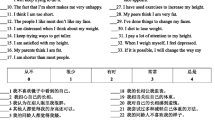Abstract
The present study aimed to explore the predicting role of selfie-editing in cosmetic surgery consideration among adolescents. The influence of facial dissatisfaction on adolescents’ cosmetic surgery consideration was also investigated. Furthermore, we examined the possible mediating effects and the potential gender differences in the mediation model. The model was tested with 767 Chinese adolescents (383 boys and 384 girls, mean age = 15.78 at Time 1, SD = 1.96) using a longitudinal design. Participants completed selfie-editing, facial dissatisfaction, and cosmetic surgery consideration at baseline and at 6-month follow-up. Results showed that the initial selfie-editing and facial dissatisfaction positively predicted the subsequent cosmetic surgery consideration among adolescents over time. Facial dissatisfaction mediated the link from selfie-editing to cosmetic surgery consideration. No gender differences were found in the mediation model. The findings of this study provide new insight into the relationship between selfie activities and cosmetic surgery and have practical implications for reducing cosmetic surgery among adolescents.



Similar content being viewed by others
Data Availability
The datasets generated during and/or analysed during the current study are available from the corresponding author on reasonable request.
References
Abbas, O. L., & Karadavut, U. (2017). Analysis of the factors affecting men’s attitudes toward cosmetic surgery: Body image, media exposure, social network use, masculine gender role stress and religious attitudes. Aesthetic Plastic Surgery, 41, 1454–1462.
Ashikali, E.-M., Dittmar, H., & Ayers, S. (2016). Adolescent girls’ views on cosmetic surgery: A focus group study. Journal of Health Psychology, 21(1), 112–121.
Avalos, L., Tylka, T. L., & Wood-Barcalow, N. (2005). The body appreciation scale: Development and psychometric evaluation. Body Image, 2(3), 285–297.
Berg, L. (2018). Young consumers in the digital era: The selfie effect. International Journal of Consumer Studies, 42(4), 379–388.
Berros, P., Armstrong, B. K., Foti, P., & Mancini, R. (2018). Cosmetic adolescent filler: An innovative treatment of the “selfie” complex. Ophthalmic Plastic and Reconstructive Surgery, 34(4), 366–368.
Cash, T. F. (2012). Cognitive-behavioral perspectives on body image. In T. F. Cash (Ed.), Encyclopedia of body image and human appearance (Vol. 2, pp. 334–342). San Diego, CA: Academic Press.
Chen, H., Jackson, T., & Huang, X. (2006). The negative physical self scale: Initial development and validation in samples of Chinese adolescents and young adults. Body Image, 3(4), 401–412.
Ching, B. H.-H., & Xu, J. T. (2019). Understanding cosmetic surgery consideration in Chinese adolescent girls: Contributions of materialism and sexual objectification. Body Image, 28, 6–15.
Chua, T. H. H., & Chang, L. (2016). Follow me and like my beautiful selfies: Singapore teenage girls’ engagement in self-presentation and peer comparison on social media. Computers in Human Behavior, 55, 190–197.
Cohen, R., Newton-John, T., & Slater, A. (2018). ‘Selfie’-objectification: The role of selfies in self-objectification and disordered eating in young women. Computers in Human Behavior, 79, 68–74.
de Vries, D. A., Peter, J., Nikken, P., & de Graaf, H. (2014). The effect of social network site use on appearance investment and desire for cosmetic surgery among adolescent boys and girls. Sex Roles, 71(9–10), 283–295.
DeGennaro, T. (2018).Chinese plastic surgery trends you need to know about (2019). Dragon Socials. https://www.dragonsocial.net/blog/chinese-plastic-surgery-trends-you-need-to-know-about/. Accessed 10 June 2020.
Deloitte. (2018). China medical cosmetology O2O market analysis. https://www2.deloitte.com/cn/en/pages/life-sciences-and-healthcare/articles/china-medical-cosmetology-o2o-market-analysis.html. Accessed 12 June 2020.
Ellison, N. B., Steinfield, C., & Lampe, C. (2007). The benefits of Facebook “friends:” social capital and college students’ use of online social network sites. Journal of Computer-Mediated Communication, 12(4), 1143–1168.
Fan, J. (2017).China’s selfie obsession—Meitu’s apps are changing what it means to be beautiful in the most populous country on earth. The New Yorker https://www.newyorker.com/magazine/2017/12/18/chinas-selfie-obsession. Accessed 13 June 2020.
Fan, J. (2018).China’s selfie culture: Youth obsessed with the power of appearances. South China Morning Post. https://www.scmp.com/magazines/post-magazine/long-reads/article/2141257/chinas-selfie-culture-youth-obsessed-power. Accessed 13 June 2020.
Fox, J., & Vendemia, M. A. (2016). Selective self-presentation and social comparison through photographs on social networking sites. Cyberpsychology, Behavior and Social Networking, 19(10), 593–600.
Henderson-King, D., & Henderson-King, E. (2005). Acceptance of cosmetic surgery: Scale development and validation. Body Image, 2(2), 137–149.
Higgins, E. T. (1987). Self-discrepancy: A theory relating self and affect. Psychological Review, 94(3), 319–340.
Holland, G., & Tiggemann, M. (2016). A systematic review of the impact of the use of social networking sites on body image and disordered eating outcomes. Body Image, 17, 100–110.
Honigman, R. J., Phillips, K. A., & Castle, D. J. (2004). A review of psychosocial outcomes for patients seeking cosmetic surgery. Plastic and Reconstructive Surgery, 113(4), 1229–1237.
Inkwood Research. (2020). Asia Pacific cometic surgery and procedure market forecast 2019–2027. https://www.inkwoodresearch.com/reports/asia-pacific-cosmetic-surgery-and-procedure-market/I. Accessed 9 June 2020.
International Society Aesthetic Plastic Surgery. (2018). Worldwide cosmetic surgery trends to watch for in 2018! https://www.isaps.org/blog/worldwide-cosmetic-surgery-trends-watch-2018/I. Accessed 20 May 2020.
Jackson, T., & Chen, H. (2015). Predictors of cosmetic surgery consideration among young Chinese women and men. Sex Roles, 73(5–6), 214–230.
Katz, E., Blumler, J. G., & Gurevitch, M. (1973). Uses and gratifications research. Public Opinion Quarterly, 37(4), 509–523.
Lonergan, A. R., Bussey, K., Mond, J., Brown, O., Giffiths, S., Muray, S. B., et al. (2019). Me, my selfie, and I: The relationship between editing and posting selfies and body dissatisfaction in men and women. Body Image, 28, 39–43.
Lunde, C. (2013). Acceptance of cosmetic surgery, body appreciation, body ideal internalization, and fashion blog reading among late adolescents in Sweden. Body Image, 10(4), 632–635.
Luo, W. (2013). Aching for the altered body: Beauty economy and Chinese women's consumption of cosmetic surgery. Womens Studies International Forum, 38, 1–10.
Lyu, S. O. (2016). Travel selfies on social media as objectified self-presentation. Tourism Management, 54, 185–195.
MarketingToChina. (2018). Booming plastic surgery market in China. https://www.marketingtochina.com/booming-plastic-surgery-market-china/. Accessed 3 June 2020.
Markey, C. N., & Markey, P. M. (2009). Correlates of young women’s interest in obtaining cosmetic surgery. Sex Roles, 61(3–4), 158–166.
Markey, C. N., & Markey, P. M. (2010). A correlational and experimental examination of reality television viewing and interest in cosmetic surgery. Body Image, 7(2), 165–171.
Matera, C., Nerini, A., & Stefanile, C. (2018). Why are men interested in cosmetic surgery procedures? Examining the role of different forms of peer influence, social comparison, internalization, and body dissatisfaction. Body Image, 26, 74–77.
McLean, S. A., Paxton, S. J., Wertheim, E. H., & Masters, J. (2015). Photoshopping the selfie: Self photo editing and photo investment are associated with body dissatisfaction in adolescent girls. International Journal of Eating Disorders, 48(8), 1132–1140.
Meng, N., Wang, Y., & Lei, L. (2017). The relationship between selfie editing and subjective well-being among female college students: The mediating role of positive feedback and self-concept. Psychological Development & Education, 33(6), 751–758.
Menzel, J. E., Sperry, S. L., Small, B., Thompson, J. K., Sarwer, D. B., & Cash, T. F. (2011). Internalization of appearance ideals and cosmetic surgery attitudes: A test of the tripartite influence model of body image. Sex Roles, 65(7–8), 469–477.
Mills, J. S., Musto, S., Williams, L., & Tiggemann, M. (2018). “Selfie” harm: Effects on mood and body image in young women. Body Image, 27, 86–92.
Mintz, Z. (2014).Selfies and plastic surgery: How social media is causing more people to go under the knife for cosmetic purposes. International Business Times. https://www.ibtimes.com/selfies-plastic-surgery-how-social-media-causing-more-people-go-under-knife-cosmetic-1616916. Accessed 12 June 2020.
Özgür, E., Muluk, N. B., & Cingi, C. (2017). Is selfie a new cause of increasing rhinoplasties? Facial Plastic Surgery, 33(4), 423–427.
Rauhala, E., Xu, Y., & Gu, J. (2016).What Chinese women want: Pale skin, big eyes, and a pointy chin. The Washington Post. https://www.washingtonpost.com/news/worldviews/wp/2016/08/04/what-chinese-women-want-pale-skin-big-eyes-and-a-pointy-chin/?noredirect=on. Accessed 7 June 2020.
Reaney, P. (2014).The selfie is driving a huge demand for plastic surgery in the US. Business Insider. https://www.businessinsider.com/r-nip-tuck-click-demand-for-us-plastic-surgery-rises-in-selfie-era-2014-11/?r=AU&IR=T. Accessed 10 May 2020.
Rohrich, R. J., & Cho, M.-J. (2018). When is teenage plastic surgery versus cosmetic surgery okay? Reality versus hype: A systematic review. Plastic and Reconstructive Surgery, 142(3), 293e–302e.
Ruggiero, T. E. (2000). Uses and gratifications theory in the 21st century. Mass Communication & Society, 3(1), 3–37.
Sarwer, D. B. (2019). Body image, cosmetic surgery, and minimally invasive treatments. Body Image, 31, 302–308.
Sharp, G., Tiggemann, M., & Mattiske, J. (2014). The role of media and peer influences in Australian women's attitudes towards cosmetic surgery. Body Image, 11(4), 482–487.
Smith, T. (2018).Men & makeup: The changing face of Chinese beauty. Jing Daily. https://jingdaily.com/men-make-up/. Accessed 15 June 2020.
Statista. (2019). Total global cosmetic surgery and procedures market in 2016 and a forecast for 2026. https://www.statista.com/statistics/939420/cosmetic-surgery-and-procedures-market-worldwide/. Accessed 6 June 2020.
Stefanone, M. A., Yue, Z., & Toh, Z. (2019). A social cognitive approach to traditional media content and social media use: Selfie-related behavior as competitive strategy. New Media & Society, 21(2), 317–335.
Sun, Q. (2018). Materialism, self-objectification, and capitalization of sexual attractiveness increase young Chinese women’s willingness to consider cosmetic surgery. Frontiers in Psychology, 9, 1–7.
Swami, V., Chamorro-Premuzic, T., Bridges, S., & Furnham, A. (2009). Acceptance of cosmetic surgery: Personality and individual difference predictors. Body Image, 6(1), 7–13.
Thompson, J. K., Heinberg, L. J., Altabe, M., & Tantleff-Dunn, S. (1999). Exacting beauty: Theory, assessment, and treatment of body image disturbance. Washington, DC: American Psychological Association.
Veldhuis, J., Alleva, J. M., Bij de Vaate, A. J., Keijer, M., & Konijn, E. A. (2018). Me, my selfie, and I: The relations between selfie behaviors, body image, self-objectification, and self-esteem in young women. Psychology of Popular Media Culture.
Walther, J. B. (1996). Computer-mediated communication: Impersonal, interpersonal, and hyperpersonal interaction. Communication Research, 23(1), 3–43.
Wang, Y., Fardouly, J., Vartanian, L. R., & Lei, L. (2019). Selfie-viewing and facial dissatisfaction among Chinese adolescents: A moderated mediation model of general attractiveness internalization and body appreciation. Body Image, 30, 35–43.
Wen, H. (2009). “Being good-looking is capital”: Cosmetic surgery in China today. Asian Anthropology, 8(1), 89–107.
Wen, H. (2013). Buying beauty: Cosmetic surgery in China. Hong Kong: Hong Kong University Press.
Wen, N., Chia, S. C., & Hao, X. (2017). Does gender matter? Testing the influence of presumed media influence on young people's attitudes toward cosmetic surgery. Sex Roles, 76(7–8), 436–447.
Yue, P. (2017).About face: China’s plastic surgery market grows six times faster than global average. China Money Network. https://www.chinamoneynetwork.com/2017/08/09/about-face-chinas-plastic-surgery-market-grows-six-times-faster-than-global-average. Accessed 20 June 2020.
Acknowledgements
This study was supported by Project funded by China Postdoctoral Science Foundation (2020M680268).The authors thank Jinjin Guo, Jiayi Wang, Lipeng Yin, Jie Long, and Yuan Fang for assistance in data collection and data entry and thank Dr. Xiaochun Xie and Dr. Xingchao Wang for their help in the revision.
Author information
Authors and Affiliations
Corresponding author
Ethics declarations
Conflict of Interest
On behalf of all authors, the corresponding author states that there is no conflict of interest.
Ethical Approval
All procedures performed in studies involving human participants were in accordance with the ethical standards of the institutional and/or national research committee and with the 1964 Helsinki declaration and its later amendments or comparable ethical standards.
Informed Consent
Informed consent was obtained from all individual participants included in the study.
Additional information
Publisher’s note
Springer Nature remains neutral with regard to jurisdictional claims in published maps and institutional affiliations.
Rights and permissions
About this article
Cite this article
Wang, Y., Chu, X., Nie, J. et al. Selfie-editing, facial dissatisfaction, and cosmetic surgery consideration among Chinese adolescents: A longitudinal study. Curr Psychol 41, 9027–9037 (2022). https://doi.org/10.1007/s12144-020-01280-4
Accepted:
Published:
Issue Date:
DOI: https://doi.org/10.1007/s12144-020-01280-4




